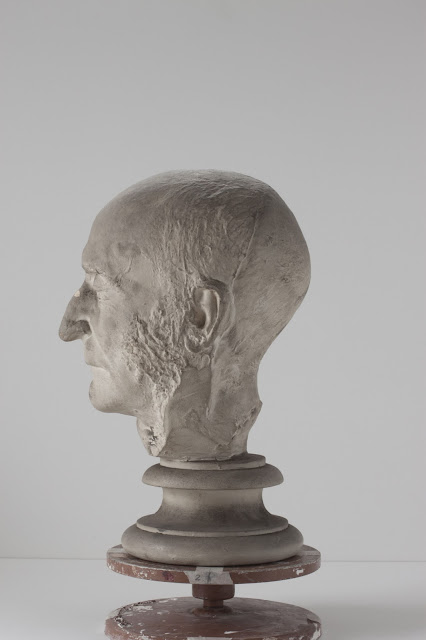Guest Post: Robert Graves' Death Mask
Today’s guest post come from Bryony
Swain, a recent graduate of History from University College London, she had
been volunteering with the UCL Museums and Collections department since October
2014.
While volunteering in UCL’s Museums and Collections department I have been cataloguing a brilliant collection they
have of life and death masks, which were collected by the phrenologist Robert
Noel in the 19th century. Phrenology is the theory that measurements
of a person’s skull can identify character traits. Noel used the masks in an
attempt to prove his theories on phrenology. Today phrenology is discredited, but
during the 19th and early 20th century it was very
popular among scientists.
Noel divided his collection into
categories; ‘intellectual’ males, ‘ladies displaying intellectual and moral
qualities’ and ‘criminals and suicides’, in order to illustrate that those of
intellectual and moral standing had a different skull to criminals and those
who committed suicide.
Whilst researching the individuals
behind the masks I came across Robert James Graves (1796-1853), a distinguished
Irish physician and surgeon.
 |
Graves Death Mask
(Reproduced by permission of UCL Museum and Collections) |
Graves obtained a medical degree from Trinity
College, Dublin in 1818. He was quite the traveller and the artist Joseph
Turner accompanied him for some of his European journeys. Whilst in Austria,
Graves was arrested and accused of being a spy because they did not believe an
Irishman could speak such good German! His adventurous life is further captured
in the story about a boat trip to Sicily. During a storm the boat came into
difficulty with the crew about to abandon ship. Graves made a hole in the
lifeboat leaving all on board to the same fate and managed to fix the problem
and got all on board to safety. Graves returned to Ireland and his impressive
medical career began. He became President of the Royal College of Physicians of
Ireland in 1843.
Graves clearly had a remarkable
life. In his book, Noel adds a personal element to his biographical history.
For instance, Noel recounts how Graves asked his students to only speak about
their patients’ illnesses in Latin so to not distress them. For Noel this
accounts for the phrenological measurement of “Benevolence”. Furthermore, he
writes how Graves “took great interest, too, in the wards devoted to children, and the
judicious and kindly treatment of the juvenile patients: and this fact agrees
with the finely curved and prominent occiput." This is an example of
Noel using aspects of a person’s life to subjectively support his theories, however
it does give a deeper insight into Graves’ life.
A lot can also be learnt about
the shape of Graves’ head. Along with measurements Noel notes, "The cast of
this head is large in every direction. It belongs to what anthropologists call
the dolichocephalic class. The frontal lobe, the seat of the intellect, is very
large; and… the seat of love for children is particularly prominent.” In
phrenological terms, Graves clearly had a good head! Although the scientific
accuracy of Noel’s work is questionable, it does give
personal information about historical figures, like Graves, which would be left
out of more formal histories.
 |
Side view of Graves' Death Mask
(Reproduced by permission of UCL Museum and Collections) |
Unlike other individuals in the
intellectual category Noel did not know Graves personally. He explains how he acquired
Graves’ death mask from the sculptor Bruce Joy, “who has executed a bust of Dr. Graves, to be
placed, I believe, in the University Building of Dublin. This copy of the
post-mortem cast, which Mr. Joy had received for the execution of his work, had
been given to me by him." I believe that this may well be the statue
of Graves that is in the Royal College of Physicians of Ireland, which is
certainly the work of Bruce Joy. Hopefully the two can be reunited for display!
 |
| Statue of Robert Graves by Bruce Joy in RCPI |
Bryony Swain
UCL Museum and Collections Deparment